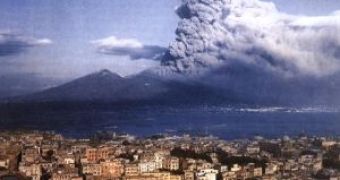Vesuvius is the only volcano in the European mainland that erupted in historical times.
This volcano is currently under a temporary sleep by more than six decades, but scientists warn that the next big eruption could be as big as that one in AD 79, which buried the ancient cities of Pompeii and Herculaneum and killed roughly 16,000 people.
The crater is 1280m tall and located just 20km (12 miles) away from Naples, Italy's third largest city. But today, the population living around the volcano is about 3 million; at least 300,000 of those living nearby would be killed by the next eruption if not evacuated beforehand, according to the first three-dimensional computer simulation of an eruption.
But, up to 200,000 inhabitants on the north-northwestern areas of the high-risk "Red Zone" could have more time to flee due to the volcano's Mount Somma rim, which is like a natural barrier. "For the first time, we have seen that these flows could be substantially diverted," said lead researcher Augusto Neri, of the National Geophysical and Vulcanology Institute in Pisa. "It seems that Mount Somma acts as an effective barrier. But this doesn't mean that they're safe."
There is an official plan to evacuate the approximately 0.5 million civilians inhabiting 18 towns within a 7 km radius of Vesuvius who face the highest risk, and everyone would reach safety within a week.
This research comes with a scientific approach on the issue. "We've already passed the civil protection authorities these results. They are going to consider some of the results of this simulation in the revision of their emergency plan," he said. "History looked set to repeat itself by pummelling modern-day communities around the ruins of Pompeii and Herculaneum. The pyroclastic flows are going to be pushed to the south-side, toward the sea. That's where Pompeii and Herculaneum are", said Peter Baxter, at Cambridge University's Institute of Public Health.
"The Vesuvius computer simulation was the first in 3-D that showed what a big eruption would look like over a period time, factoring in complex variables such as topography", said Neri.
In fact, the team simulated the collapse of the eruption column, when the exploding mushroom cloud is heavier than the air, and the ash and smoke flow rapidly down the sides of the volcano. The magma temperature would reach 950? C inside the crater and 200? C at the outer edge of the Red Zone, 7km (4 miles) away. "The team partly based its research on an eruption in 1631 that killed 4000 people", said Carlo Cavazzoni, who helped develop the code that allowed the super-computer to interpret the data. "Many more simulations are needed the 3-D model is a major step forward. It's the first time that such a complete model has been applied at Vesuvius," said Neri.

 14 DAY TRIAL //
14 DAY TRIAL //